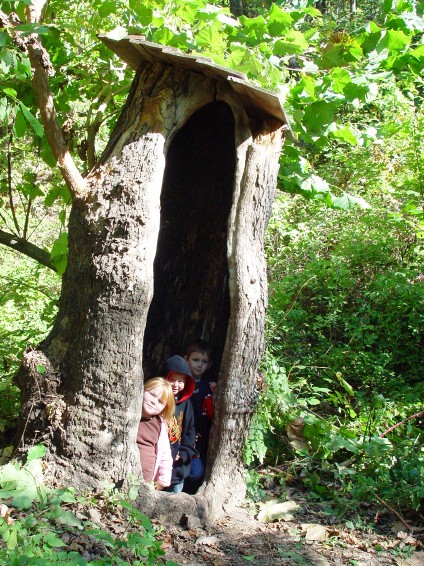
Photo courtesy Keith Stokes
Schermerhorn Park is a finalist because...
it represents the small part of the Ozarks that extends into Kansas, including steep bluffs of Mississippian-age limestone, a 2,500-foot-long cave, endangered species, clear-running Shoal Creek, WPA-era stone terraces, hiking trails, and a nature center.
Located: 1.5 miles south on K-26 from downtown Galena. Just before Shoal Creek Bridge, turn east into the park.
ABOUT SCHERMERHORN PARK
Source: http://www.seksnaturecenter.com/
In 1922, Edgar Backus Schermerhorn, a wealthy citizen of Galena, donated land south of Galena on Shoal Creek for the purpose of building a city park. During the mid 1930's and early 1940's the W.P.A. (Works Progressive Administration) built the park's well-known stone terracing walls and
other structures. Just inside the entrance there are picnic and cooking areas as well as a playground.
Route 66 travelers would stop here in the 1920s for a refreshing dip in Shoal Creek.
Schermerhorn Park is one of the greatest places to experience the "Kansas Ozarks". The city maintained park is a biological wonderland. The park is alive with examples of native wildlife. The spring that flows from Schermerhorn Cave, located in the park, is home to the dark-sided salamander, the cave salamander and the graybelly salamander, all on the Kansas endangered list. Also birders from all over the state know the park for its wide variety of birds found in the area.
Probably the best place to see examples of Mississippian limestone of the Ozark Plateau is located at Schermerhorn Park. Shoal Creek, one of the major tributaries to Spring River, flows through the park. This spring-fed, ozarkian stream has been the major force shaping the basin, producing the physiographic features so common to the Ozark region--rolling hills and steep river bluffs. The park sits at the west end of a tall limestone bluff on the north side of the river.

Photo courtesy Linda Phipps
THE SOUTHEAST KANSAS NATURE CENTER
The historic scout cabin in Schermerhorn Park has been transformed into the wonderful Southeast Kansas Nature Center. Animal and plant exhibits native to the area are displayed throughout the center. Exploration drawers are filled with hands-on materials.
Environmental education classes and workshops are offered each month. The adjoining park grounds, trails, cave and creek make a perfect setting for science and nature studies.
MORE ABOUT THE OZARK PLATEAU PHYSIOGRAPHIC REGION
Source:
http://www.naturalkansas.org/schermerhorn.htmGeological remnants of Mississippian times are found in the limestone cave region of the 55-square mile Ozark Plateau in the very southeast corner of Kansas. The cherty limestones of the area were developed in marine environments during the late Mississippian Period (345 million years ago). Today it is characterized by sinkholes, caves, swift streams and steep cliffs. The well drained cherty soils are poorly suited for agricultural use. Because of rich veins of lead and zinc ores below the surface, this tri-state district became a lead and zinc mining center of worldwide importance in the early 20th century. Much of the original Ozark Oak-Hickory forestlands still remain in this region. The white and Shumard's oaks, and bitternut and shagbark hickorys dominate the landscape of steep limestone bluffs and clear streams.
SCHERMERHORN CAVE
Source:
www.showcaves.com/english/usa/caves/Schermerhorn.html
The only part of the Ozark Plateau that belongs to Kansas is an area in southeast Cherokee County. The underground is Mississippian limestones which are karstified. There are only a few caves but this one is at least developed to the entrance. There is a trail and viewing platform for the impressive cave portal at the foot of a cliff.
The cave entrances and brooks in this area are famous for there various animals, especially amphibians, a lot of them are endangered. Schermerhorn Cave is considered the most biologically diverse cave in Kansas. The cave is used by bats like eastern pipistrelle and gray myotis. Big brown, and red bats live in the area.
There is a local lure, that Jesse James hid in the cave entrance.